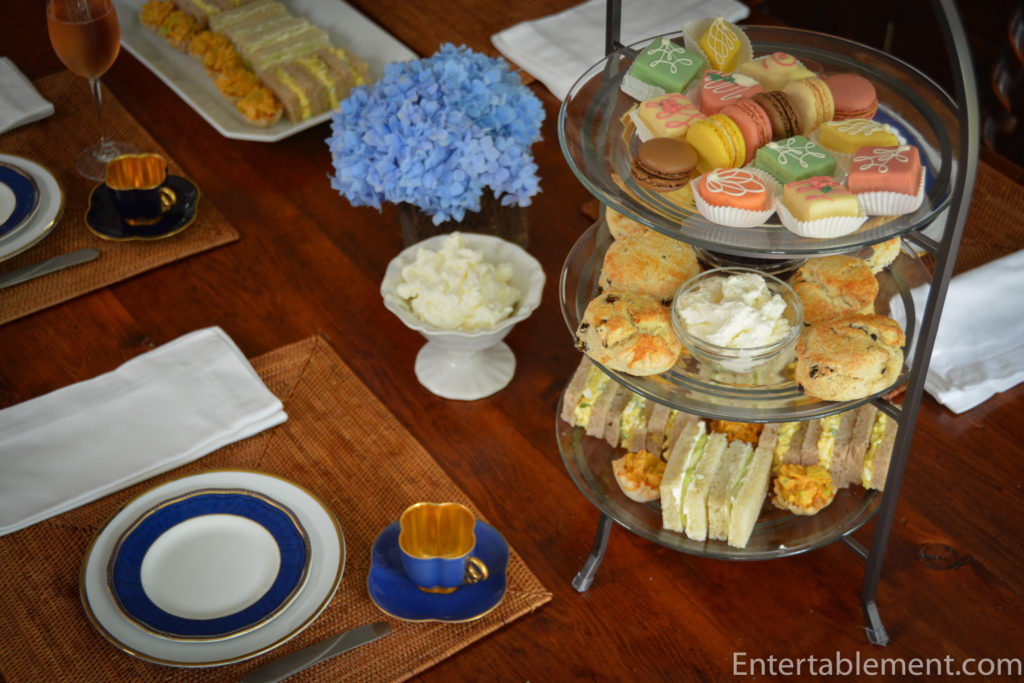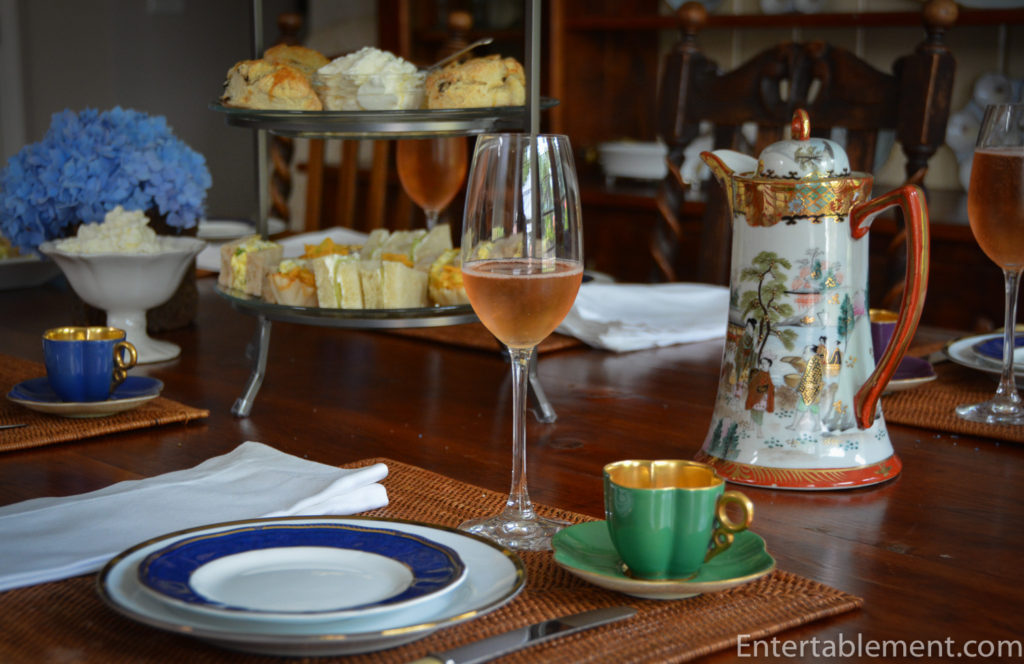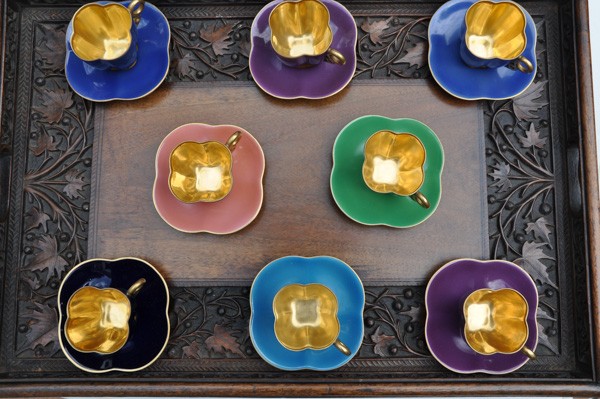Scones can be a divisive food. To start with, there is the pronunciation. I say scone (like gone), you say scone (like bone).
Their composition is quite different, and depending on which side of the pond you’re from, what is familiar is “normal”. British scones tend to be lean and neat with a fine crumb. They’re usually plain or contain a sprinkling of dried fruit such as sultanas or candied peel. They’re mostly eaten in the afternoon. American scones drift to bigger, shaggier, and generally more opulent; they’re made with more fat and sometimes topped with sugar. Often for sale as a breakfast item, they may contain ham and cheese or be made with additional ingredients such as pumpkin.
Then there is the whole “cream scone” debate. A ”cream scone” in Britain usually refers to its serving companion, clotted or Devonshire cream. In North America, scones are frequently made with cream rather than milk or buttermilk; see what I mean about the fat content?.
This recipe is of the British variety. They’re quite plain but deliciously flaky and tender. We love them with clotted or whipped cream and jam as part of a full-blown afternoon tea complete with savouries and sweets, or just on their own for a light repast.

Scones with Dried Currants
A traditional British scone made with currants.
- Yield: 8 1x
Ingredients
- 340 g (3 c or 12 oz) self-raising or pastry flour, plus more for dusting
- 37 g (3 tbsp or 1.3 oz) granulated sugar
- 1 tsp (6 g) baking powder
- ¼ tsp salt
- 85 g (6 tbsp or 3 oz) cut into cubes
- 75 g (1/2 c or 2.6 oz) dried currants
- 175 ml (3/4 c or 6 fluid oz) buttermilk at room temperature
- 1 egg
Instructions
- Heat oven to 400° F or 375° Convection.
- Add the flour, sugar, baking powder and salt to a large bowl and whisk together. Add the butter and rub it in with your fingers until the mix looks like fine crumbs. Add the currants and mix.
- Make a well in the dry ingredients, then add the buttermilk and stir with a fork until combined; it will seem pretty wet at first.
- Flour a work surface and tip the dough onto it. Flour your hands, scatter a bit of flour over the dough and fold it over a few time until it’s a bit smoother; shape it into a circle about 2″ high.
- Dip a 2.5″ round cutter in flour and press it firmly down into the dough, repeating as many times as you can (likely four, possibly five times). Gather the scraps together and repeat until you have eight or nine scones. Place them on a parchment-lined baking tray and brush the tops with the beaten egg.
- Bake until risen and golden on the top (about 10 minutes).
- Serve and enjoy!
Notes
- The scones can be eaten warm or cold on the day of baking. Serve with jam and Devonshire cream or with lemon curd.
- They can also be frozen and refreshed in a 350° F oven for a few minutes before serving.

I made this bunch for an afternoon tea with the granddaughters during a recent visit. The sweet course was purchased macarons and petit fours from World Market.
I adore petit fours. When I was a child, my Mum would bring them home from a local patisserie on occasion and we would have them for a special treat. The soft pastel-coloured fondant icing was a source of endless fascination, enrobing the delicate layers of sponge cake, jam and whipped cream beneath. In my affections, they were second only to the pastel-coloured meringue nests which she filled with fruit and topped with whipped cream. I see a trend here…
For the savouries course, we had crustless egg salad with chives sandwiches, cucumber & cream cheese sandwiches and Coronation chicken in phyllo cups. I studiously avoided the dreaded raisin or cranberry in any of the sandwiches. The girls each tried a bit of scone and grudgingly admitted that currants were not quite as bad as raisins. As a vehicle for whipped cream, they were superb!
We used the Black Knight harlequin quatrefoil demitasse cups, which are perfectly sized for little hands.
The girls had cambric tea (black tea with a lot of milk) which they very much enjoyed, much to our surprise. The grown-ups enjoyed a glass of pink champagne as well.
The teapot is actually a Vintage Takito Gilded Moriage Chocolate Pot from the 1930s. I liked the way it picked up the gilding from the inside of the teacups and most of the colours, and the size was in keeping with the demitasses. It was an Etsy find. The plates are Wedgwood Crown Sapphire bread & butter plates from eBay and they sat on Pier 1 gilded edge salad plates (discontinued). It all cobbled together into a fun, eclectic tea set.
It’s so much fun to introduce the granddaughters to the joys of tea. It gives them a chance to dress up, practice their best table manners and be rewarded with a whole lot of sweet stuff. A very happy interlude was celebrated by all.
I’m sharing this post with Between Naps on the Porch.












Nicely done. The Black Knights quatrefoil cups are quite special. My granddaughter loves tea parties, too. She’s become adept at hosting her own tea parties for her dolls using her own antique children’s Blue Williw china. It really is all such a delight. Thanks for inviting us for a peek. CherryKay
Thanks, CherryKay. The antique blue willow tea set sounds delightful! How gorgeous would that be? I got my little ones tea sets from Pottery Barn Kids for Easter one year. At least, the first four. The fifth granddaughter has to be caught up on a few things!
Ms. Kain,
This tea service looks anything but cobbled together. It is just the cheerful, colorful type of table a tea with granddaughters requires. And your scones look delicious, I’m pinning your recipe.
Are you aware that Juliska is having a sale on retired items? I just ordered a group of ruby Arabella glassware at a really good price. Not sure how I’ll use them, but I could not resist.
Warmest regard,
Elizabeth Speicher
Thank you for mentioning the Juliska sale. I will head over to the site now and check it out. The Arabella ruby is gorgeous. I imagine it will be useful in any number of settings, particularly as we head into the fall and winter seasons. Good sleuthing, Ms Speicher.
Thank you again. Have a lovely day!
If you think macarons are good, next time you pass through Zürich airport, try the Luxemburgerli from the beautiful Sprüngli shop, a fixture in Zürich for over 175 years. They are small, light, bursting with exotic flavours; a cloud that dissolves in your mouth. Unfortunately, their shelf life is only 3 days, so you can’t order them unless you plump for air delivery in addition to the ruinous base price! Even so, it would be like ordering clotted cream sent from Devon…Just. not. the. same.
https://www.spruengli.ch/cms/en/
P.S.: Raisins, craisins, and cranberries do not belong in food. lol
I see you belong to the Dreaded Raisin Club. Not fond of granola, I take it? hehe
My daughter Lauren makes marvellous macarons, so we are very spoiled. She wasn’t with us in the Cape for the tea party but is often happy to oblige for Canadian events. The little box of dyes that she has for all the different exotic colours is endlessly intriguing to us all. As is watching her make the macarons. The tops and bottoms have to be piped into circles of exactly the same size, and then the filling has to be piped so as not to ooze over the edge when the macaron is assembled, nor yet be too skimpy so as not to fill it out. It’s the matter of the greatest delicacy. I find it hysterically amusing that my most tomboyish daughter has the profession requiring the deftest and daintiest touch.
Hello – this is simply beautiful – from the food to every piece used in serving. In the US we are able to buy “clotted cream” but only in jars (though purportedly from Britain). It’s all okay, but having had your clotted cream in all parts England, I’d rather have fresh. Do you have any recommendations, or should I just try and make it myself?
Thanks and know you had a wonderful time at this Tea.
Thank you, Margaret! Most of the clotted cream in Britain comes in jars as well, so I would not be averse to trying them in the US. At the tea shops in the National Trust locations, it comes in little foil-topped containers and is quite good. My kids actually prefer whipped cream as it’s lighter. Everyone to their own taste!
Thank you – that is encouraging! We’ll be in Wales and England in September and will play food detectives and track down some of the clotted creams and how they are packaged.
Ah, Helen, the debate in Britain over pronunciation (depends which part of the country you’re from, I’m told) is matched only by indecision over whether to put the clotted cream on before the jam (Devon) – or vice versa (Cornwall)! Just to make things worse, Scone Palace in Perthshire, traditional crowning-place of Scottish kings, is pronounced ‘Skoon’. 🙂 Love your photos – makes me feel quite hungry!
Isn’t that the truth, Mike? I’m given to understand the Queen goes for jam first, then cream. Myself, I’m a cream first, then jam person (seems more logical to me, like buttering your toast before adding the jam). And yes, the stone of “Skoon”. Whodda thunk???
I so much enjoy your blogs and sent your latest one about “Biggles” to my husband to read. We’ll be in England later this year and he will be going on a Spitfire flight over the Channel out of the Goodwood airfield. He’s in heaven in anticipation.
Thanks, Helen! Your husband’s a very lucky chap – every schoolboy’s dream! In the news today, the youngest Spitfire pilot to fly in the Battle of Britain has died. Geoffrey Wellum was just 18 when he joined the RAF. While you’re down that way, there’s an RAF museum at Tangmere (not sure how good it is) and the Weald & Downland open air museum is just fabulous – http://bitaboutbritain.com/weald-and-downland/ – though there plenty of stately homes too, which you’ve probably already researched!
Thanks so much for the museum information, Mike. We’ve seen Duxford and went to the big air show last autumn – 13 Spitfires flying in formation. It was incredible. It’s impossible to see everything we want to, no matter how often we get to Britain! Happy problem to have, I know…
Talk of dairy products in Cornwall reminds me of this:
My goodness! I picked up every fifteenth word, I think. Hahaha
And the next YouTube that comes up is that wonderful Heathrow Airport advert with the Teddy Bears!
I can imagine the oohs and aahs from your granddaughters when they saw your pretty table. I think starting them early to enjoy the beauty of everyday life will see them through a lifetime.
That’s the idea, Sandra. A quiet appreciation of daily delights sees us through a lifetime.
I thoroughly enjoyed this post. I love the idea of afternoon tea and sharing it with your granddaughters is terrific. When my girls were young an aunt gave all of the nieces a tea party as their birthday gift. It was actually sold at an auction as a fundraiser and all of the girls met together at the appointed time at an area bed and breakfast. They came dressed up either in their own clothing or some came in their mother’s dresses and heels. The hostess had a collection of hats, purses and gloves for them to wear. I think that the tea was actually Koolaid that was served with cookies but they had fun. Your table is beautiful as is your food. I am a fan of scones and my favorites to bake are the cream scones, made with cream. I have also tried the macarons with mixed results. Some have turned out perfect others have hollow centers or missing feet. I am inspired to give them another try.
What a fun occasion for your daughters and nieces; not only getting to enjoy the food, but the dress up clothes must have made the event really special.
Macarons are very tricky. I find anything meringu-ish to be fraught; the freshness of the eggs, the humidity… Good on you for persevering Lorri!